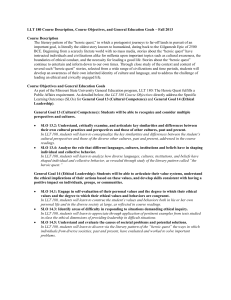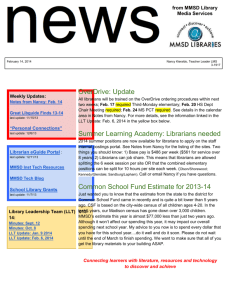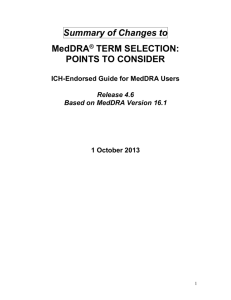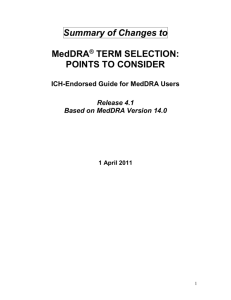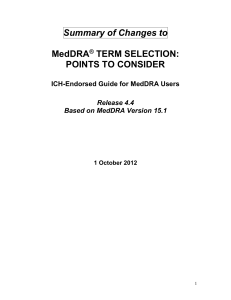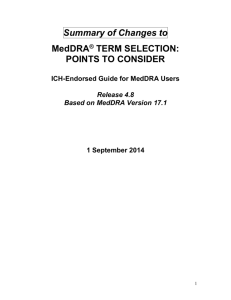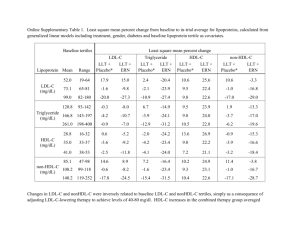Throughout document
advertisement
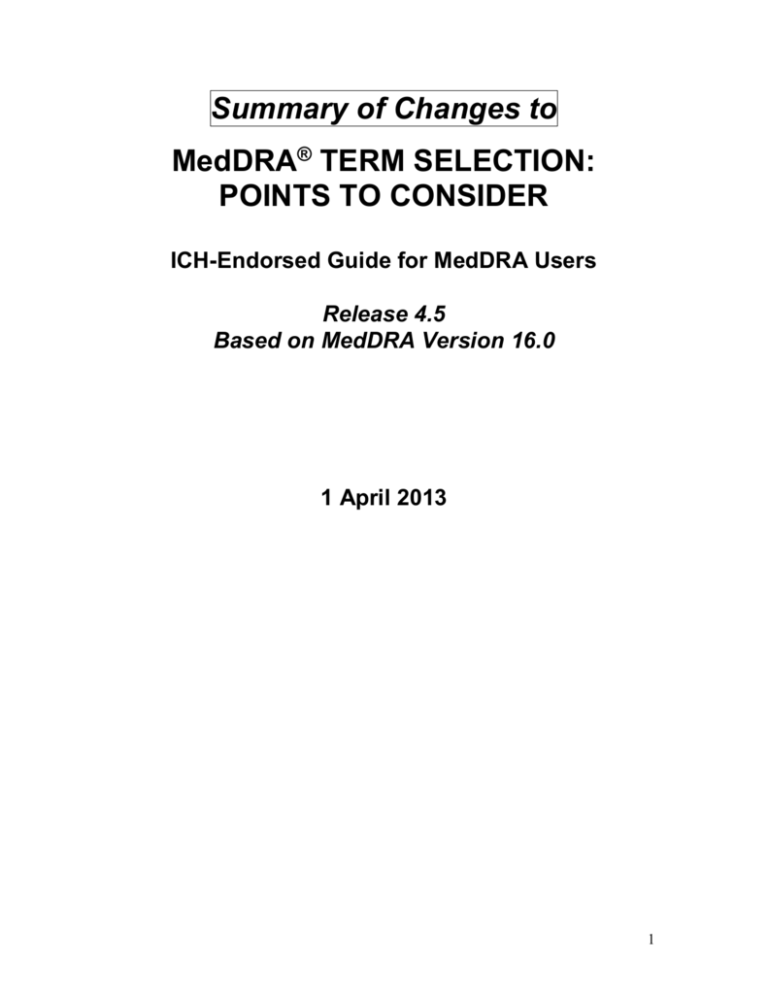
Summary of Changes to MedDRA® TERM SELECTION: POINTS TO CONSIDER ICH-Endorsed Guide for MedDRA Users Release 4.5 Based on MedDRA Version 16.0 1 April 2013 1 The following is a listing of changes made between releases 4.4 and 4.5 of MedDRA Term Selection: Points to Consider: Throughout document 1) 2) 3) 4) Correction of general spelling, punctuation, spacing, and format errors Replacement of references to MedDRA Version 15.1 to Version 16.0 Update of examples based on MedDRA version changes Correction of cross references (e.g., “See Section 3.17”) based on renumbered sections of the document 5) Wherever feasible, the preferred option – designated by a mark – is listed first in the “Example” tables. For convenience, the specific changes made are noted below. 6) Wherever feasible, in the “LLT Selected” column of the “Example” tables, the LLT listed first is now the one that reflects the topic of that particular section of the document. For convenience, the specific changes made are noted below. 1.2 – Uses of MedDRA Wording in the first paragraph: Term selection for adverse reactions/adverse events (ARs/AEs), devicerelated events, product quality issues, medication errors, medical history, social history, investigations, and indications is addressed in this MTS:PTC document. Was changed as follows (note the addition of “exposures”, “misuse and abuse” and “off label use”): Term selection for adverse reactions/adverse events (ARs/AEs), devicerelated events, product quality issues, medication errors, exposures, medical history, social history, investigations, misuse and abuse, off label use, and indications is addressed in this MTS:PTC document. 3.4.3 Vague information An additional example was added to the Example table as follows: Reported LLT Selected Patient had a medical problem of unclear type Ill-defined disorder Comment Since it is known that there is some form of a medical disorder, LLT 2 Reported LLT Selected Comment Ill-defined disorder can be selected 3.8.2 No available MedDRA term includes both microorganism and anatomic location In the Example table, the order of the options has been changed so that the preferred option is listed first in the table. Note that the term selection options – including the designated preferred option – have not changed. (See “Throughout document”, point no. 5 above). 3.9 – Modification of Pre-existing Conditions In the second Example table in this section, for Option 2, the order of the LLTs in the “LLT Selected” column has been changed so that the first LLTs (LLTs Disease progression and Condition aggravated) reflect the topic of this section. (See “Throughout document”, point no. 6 above). 3.10.1 Events in the mother The second Example table: Example Reported LLT Selected Pregnant patient receiving drug X experienced a pruritic rash Drug exposure during pregnancy Pruritic rash Comment LLT Pregnancy should also be selected for medical history, concomitant medical condition Was changed as follows (note the change for one of the LLTs selected and minor wording changes in the “Comment” column): Example 3 Reported LLT Selected Pregnant patient receiving drug X experienced a pruritic rash Maternal exposure during pregnancy Pruritic rash Comment LLT Pregnancy can be selected for medical history, concomitant medical condition 3.10.2 Events in the child or fetus In the Example table, the order of the LLTs in the “LLT Selected” column has been changed so that the first LLTs (LLTs Drug exposure in utero, Paternal drug exposure before pregnancy and Drug exposure via breast milk) reflect the topic of this section. (See “Throughout document”, point no. 6 above). In addition, the following wording was removed from the “LLT Selected” column in the last example in the table: “(See Section 3.15.3, Accidental exposures)” 3.13.2 Procedure and diagnosis are reported In the Example table, the order of the LLTs in the “LLT Selected” column (first example) has been changed so that the first LLT (LLT Liver transplantation) reflects the topic of this section. (See “Throughout document”, point no. 6 above). 3.14.5 Investigation terms without qualifiers Wording in the first paragraph: Terms in SOC Investigations without qualifiers may be used to record test names when entering diagnostic test data (such as in E2B field B.3.1c). Was changed as follows (note removal of reference to E2B field B.3.1c): Terms in SOC Investigations without qualifiers may be used to record test names when entering diagnostic test data. Also, wording of the footnote below the Example table: 4 * Enter a qualifier (e.g., “increased”) or a numeric result (if available) into the “Result” data field of the E2B format. Was changed as follows (note removal of reference to the E2B format): * Enter a qualifier (e.g., “increased”) or a numeric result (if available) into the “Result” data field. 3.15 – Medication/Administration Errors and Accidental Exposures There were extensive changes made to this section of the document to accommodate the expanded scope of topics and to consolidate various forms of medication errors into a single sub-section (renamed Section 3.15.1). First, the section name: Medication/Administration Errors and Accidental Exposures Was changed as follows: Medication/Administration Errors, Accidental Exposures and Occupational Exposures Secondly, the following wording, directly below the section name/header, was deleted (note that these two paragraphs were reversed in order and moved under Section 3.15.1): Reports of medication errors may or may not include information about clinical consequences. Appendix B of the MedDRA Introductory Guide contains descriptions of the interpretation and use of certain medication error terms (e.g., “Dispensing error”). Next, the name of sub-section 3.15.1: Medication errors reported with clinical consequences Was changed as follows: Medication/administration errors 5 And, in addition, the previous sub-sections in this part of the document were renumbered as follows: Original Section Number 3.15.1 3.15.2 Section Name/Header Medication errors reported with clinical consequences Medication errors and potential medication errors reported without clinical consequences 3.15.3 Accidental exposures 3.15.4 Medication errors in the context of labeled interactions Do not infer a medication error 3.15.5 New Section Number 3.15.1.1 3.15.1.2 MOVED and MODIFIED; see new Section 3.15.2 3.15.1.3 3.15.1.4 3.15.1 Medication/administration errors In this newly renamed section, wording that had previously been directly below the header for Section 3.15 was moved here and the order of the paragraphs reversed. In addition, the following definition of medication errors was copied from the section named Product quality issue vs. medication error (originally Section 3.27.3, now Section 3.28.3) and added to Section 3.15.1: Medication errors are defined as any preventable event that may cause or lead to inappropriate medication use or patient harm while the medication is in the control of the health care professional, patient or consumer. (Note also the minor modification by addition of the word “the” before the word “control”). 3.15.2 Accidental exposures and occupational exposures This is modified and expanded content from the original Section 3.15.3. And, there are two new sub-sections, one for Accidental exposures (Section 3.15.2.1) and one for Occupational exposures (Section 3.15.2.2). 3.15.2.1 Accidental exposures 6 Two of the examples in the Example table from original Section 3.15.3 have been moved to this section as follows: Example Reported Child accidentally took grandmother’s pills and experienced projectile vomiting Father applying topical steroid to his arms accidentally exposed his child to the drug by carrying her LLT Selected Accidental drug intake by child Vomiting projectile Exposure via skin contact 3.15.2.2 Occupational exposures This is a new section that did not exist in the prior version of this document. It consists of a definition of “occupational exposure” and three examples in an Example table. One of the three examples (“Nurse splashed injectable drug in her own eye…”) has been moved to this new section, and an explanatory Comment for this example has been added. 3.16 – Misuse, Abuse and Addiction This is a new section that did not exist in the prior version of this document. It consists of: A table to aid in comparing these three concepts (and also to compare and contrast them with medication error and off label use) One sub-section each for misuse, abuse and addiction Definitions for each of these concepts Multiple examples in Example tables Because this is a major new section of the MTS:PTC document, all subsequent sections have been renumbered. 3.17 – Transmission of Infectious Agent via Product The last sentence in the first paragraph of this section: If the infection is identified, select a second term for the specific infection. Was changed as follows: 7 If the infection is identified, select a second term for the specific infection; if appropriate, a product quality issue term can also be selected (See Section 3.28). Note also that this section number has changed from 3.16 to 3.17. Also in this section, an additional LLT was added to the Example table: Example Reported Patient received a nasal spray product and later developed a severe nasal infection with Burkholderia cepacia. Cultures of unopened containers of the nasal spray grew B. cepacia LLT Selected Transmission of an infectious agent via a medicinal product Burkholderia cepacia infection As follows (LLT Product contamination bacterial was added): Reported Patient received a nasal spray product and later developed a severe nasal infection with Burkholderia cepacia. Cultures of unopened containers of the nasal spray grew B. cepacia LLT Selected Transmission of an infectious agent via a medicinal product Product contamination bacterial Burkholderia cepacia infection Finally, the last paragraph in this section: Medical judgment should be used if the reporter does not explicitly state transmission of an infectious agent via medicinal product but this could be implied by other data within the case. In this instance, select LLT Suspected transmission of an infectious agent via a medicinal product. The same LLT should be used in the E2B field for the sender’s diagnosis (B.5.3). Was changed as follows (note substitution of the word “report” for “case” and deletion of the last sentence): Medical judgment should be used if the reporter does not explicitly state transmission of an infectious agent via medicinal product but this could be implied by other data within the report. In this instance, select LLT Suspected transmission of an infectious agent via a medicinal product. 8 3.18 – Overdose, Toxicity and Poisoning The Example table in this section: Example Reported Overdose of pills A child was accidentally poisoned when she ingested a chemical cleaning product Patient intentionally took many more than the prescribed number of pills to treat a very severe headache LLT Selected Overdose Accidental poisoning Chemical poisoning Intentional overdose Was changed as follows: Example Reported Overdose of pills A child was accidentally poisoned when she ingested a chemical cleaning product Patient intentionally took many more than the prescribed number of pills The dose of drug X taken was above the recommended maximum dose in the label Nurse inadvertently administered an additional vaccine dose to an already vaccinated child LLT Selected Overdose Comment Accidental poisoning Chemical poisoning Intentional overdose Drug overdose Inappropriate dose of vaccine administered Please note that LLT Inappropriate dose of vaccine administered is a maladministration term, not specifically an overdose term To summarize, the changes to this Example table are: Deletion of the phrase “to treat a very severe headache” from the “Reported” column, third example Addition of a new “Comment” column 9 Addition of two new examples (fourth and fifth examples in the table) Note also that this section number has changed from 3.17 to 3.18. 3.18.1 Overdose reported with clinical consequences In the Example table, the order of the LLTs in the “LLT Selected” column has been changed so that the first LLT (LLT Overdose) reflects the topic of this section. (See “Throughout document”, point no. 6 above). Note also that this section number has changed from 3.17.1 to 3.18.1. 3.19.2 Device-related event reported without clinical consequences An additional (third) example was added to the Example table: Example Reported Medical device breakage My patch is leaking on my arm LLT Selected Device breakage Leaking patch As follows: Example Reported Medical device breakage My patch is leaking on my arm My patch is not sticking to my skin LLT Selected Device breakage Leaking patch Medicinal patch adhesion issue Note also that this section number has changed from 3.18.2 to 3.19.2. 3.22 – Unexpected Therapeutic Effect 10 In the Example table, the order of the LLTs in the “LLT Selected” column has been changed so that the first LLT (LLT Unexpected therapeutic effect) reflects the topic of this section. (See “Throughout document”, point no. 6 above). Note also that this section number has changed from 3.21 to 3.22. 3.23.1 Lack of effect The Example table: Example Reported LLT Selected Preferred Option Patient took drug for a headache, and her headache didn’t go away Drug ineffective Antibiotic didn’t work Lack of drug effect Reported LLT Selected Preferred Option Patient took drug for a headache, and her headache didn’t go away Drug ineffective Drug ineffective Headache Was changed as follows: Example Antibiotic didn’t work Drug ineffective Headache Lack of drug effect Note removal of the preferred option check mark () from the second example (“Antibiotic didn’t work”). Since there is only one possible LLT selection approach for this example, a preferred option designation is not relevant. Note also that this section number has changed from 3.22.1 to 3.23.1. 11 3.26 – Indication for Product Use A second paragraph was added to this section: Indications can be reported as medical conditions, prophylaxis of conditions, replacement therapies, procedures (such as anesthesia induction) and verbatim terms such as “anti-hypertension”. Terms from almost any MedDRA SOC – including SOC Investigations – may be selected to record indications. As follows: Indications can be reported as medical conditions, prophylaxis of conditions, replacement therapies, procedures (such as anesthesia induction) and verbatim terms such as “anti-hypertension”. Terms from almost any MedDRA SOC – including SOC Investigations – may be selected to record indications. Regulatory authorities may have specific requirements for certain aspects of term selection for indications (e.g., for indications within regulated product information). Please refer to the regulatory authority’s specific guidance for such issues. Note also that this section number has changed from 3.25 to 3.26. 3.26.1 Medical conditions Additional examples were added to two of the three Example tables in this section: Example Reported Hypertension Anti-hypertensive Chemotherapy for breast cancer LLT Selected Hypertension Breast cancer Example Reported Patient received chemotherapy LLT Selected Chemotherapy 12 As follows: Example Reported Hypertension Anti-hypertensive Chemotherapy for breast cancer I took it for my cold symptoms LLT Selected Hypertension Breast cancer Cold symptoms Example Reported Patient received chemotherapy Patient received antibiotics LLT Selected Chemotherapy Antibiotic therapy Note also that this section number has changed from 3.25.1 to 3.26.1. 3.26.2 Complex indications This is a new section that did not exist in the prior version of this document. It consists of an explanatory paragraph and an Example table. 3.27 – Off Label Use Under the main section header, the following paragraph was added: The concept of “off label use” relates to situations where the product is intentionally used for a medical purpose not in accordance with the authorized product information. Note also that this section number has changed from 3.26 to 3.27. 13 3.27.1 Off label use when reported as an indication Wording in this section: “Off label use” refers to use of a product for an indication for which it is not labeled. If a medical condition is reported as an indication along with “off label use”, the preferred option is to select terms for the medical condition and LLT Off label use or other appropriate LLTs linked to PT Off label use for the “indications” field. Alternatively, select a term for the medical condition/indication alone. Select LLT Off label use alone only if it is the only information available. Was changed as follows (note deletion of first paragraph and removal of the phrase “for the indications field”): If a medical condition is reported as an indication along with “off label use”, the preferred option is to select terms for the medical condition and LLT Off label use or other appropriate LLTs linked to PT Off label use. Alternatively, select a term for the medical condition/indication alone. Select LLT Off label use alone only if it is the only information available. The phrase “for the indications field” was deleted based on user feedback and to allow for flexibility in data retrieval (i.e., not restricting the field in which these terms can be used). In the first Example table in this section, the order of the options has been changed so that the preferred option is listed first in the table. Note that the term selection options – including the designated preferred option – have not changed. (See “Throughout document”, point no. 5 above). Also, the order of the LLTs in the “LLT Selected” column (first example) has been changed so that the first LLT (LLT Off label use) reflects the topic of this section. (See “Throughout document”, point no. 6 above). Also, in the second Example table, the wording of the “Reported” information for the first example: Example Reported Off label use LLT Selected Off label use Comment Was changed as follows: 14 Example Reported Used off label LLT Selected Off label use Comment Note also that this section number has changed from 3.26.1 to 3.27.1. 3.27.2 Off label use when reported with an AR/AE Wording in this section: If an AR/AE occurs as a result of off label use, the preferred option is to select LLT Off label use, or other appropriate LLTs linked to PT Off label use, and a term for the medical condition for the “indications” field in addition to a term for the AR/AE. Alternatively, select a term for the medical condition for the “indications” field and a term for the AR/AE in the “AR/AE” field. Was changed as follows (note deletion of the phrase “for the ‘indications’ field” from two places and deletion of the last phrase of the paragraph, “in the ‘AR/AE’ field”): If an AR/AE occurs as a result of off label use, the preferred option is to select LLT Off label use, or other appropriate LLTs linked to PT Off label use, and a term for the medical condition in addition to a term for the AR/AE. Alternatively, select a term for the medical condition and a term for the AR/AE. In the Example table in this section, the order of the options has been changed so that the preferred option is listed first in the table. Note that the term selection options – including the designated preferred option – have not changed. (See “Throughout document”, point no. 5 above). Also, the order of the LLTs in the “LLT Selected” column has been changed so that the first LLT (LLT Off label use) reflects the topic of this section. (See “Throughout document”, point no. 6 above). Note also that this section number has changed from 3.26.2 to 3.27.2. 15 3.28.1 Product quality issue reported with clinical consequences A third example was added to the Example table as follows: Reported Consumer noted that the toothpaste they had purchased had a mouldy odour Subsequent investigation of the product lot number revealed that the toothpaste was a counterfeit product LLT Selected Product counterfeit Product odour abnormal Note also that this section number has changed from 3.27.1 to 3.28.1. 3.28.3 Product quality issue vs. medication error A minor edit was made to the third paragraph of this section by inserting the word “the” before the phrase “control of the healthcare professional…” Note also that this section number has changed from 3.27.3 to 3.28.3. . 4.3.1 Current members of the ICH Points to Consider Working Group Designation of the current and former Rapporteurs: Affiliation European Federation of Pharmaceutical Industries Associations US Food and Drug Administration Member Hilary Vass** Christina Winter* John (Jake) Kelsey* * Current co-Rapporteurs ** Acting Rapporteur for June 2010 meeting of Working Group Was changed as follows: 16 Affiliation European Federation of Pharmaceutical Industries Associations US Food and Drug Administration Member Hilary Vass* Christina Winter† John (Jake) Kelsey* * Current co-Rapporteurs † Former Rapporteur Also, the name of Alison Langevin (Health Canada) was changed to Alison Bennett. 17

